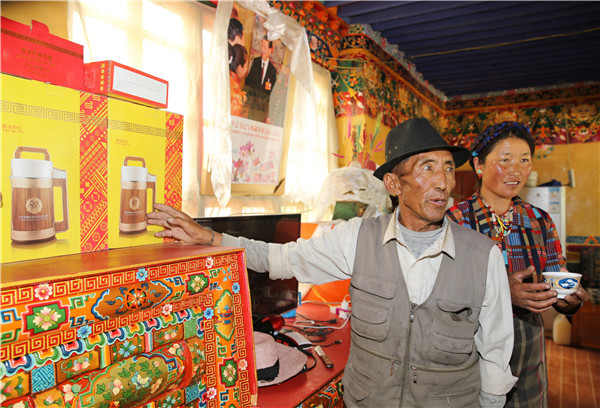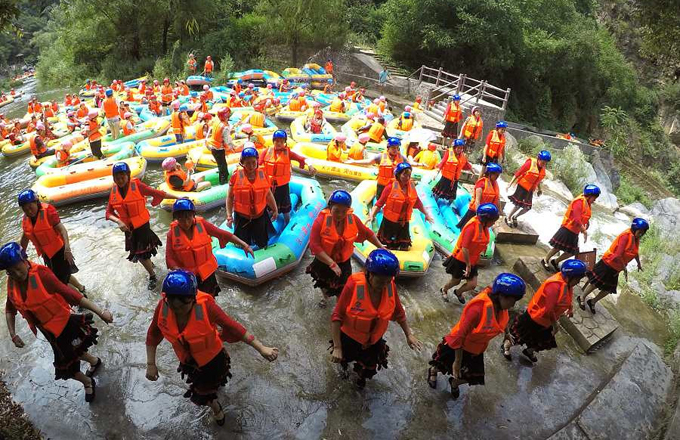Tree planting project turns barren, windy land into oasis
 |
|
Trinley, a 62-year-old Tibetan farmer, talks about the pots for buttered tea-a popular drink in Tibet-that were a gift from the regional government.[Photo by HUO YAN/CHINA DAILY] |
Ema township in the Tibet autonomous region used to be synonymous with barren, windy land on the north bank of the Yarlung Zangbo River.
It is now an oasis, thanks to a forestation campaign launched by the government.
"Even grass was rare back then, let alone trees," said Ding Kun, head of the Ema township government, speaking of the time before the projects. He clearly remembers the bleakness and desolation.
Migmar, the 52-year-old village head of Liuguo, recalled the situation when he moved to a village in Ema in 2002.
"The sand brought by a storm overnight could block the door by morning. One time in 2004 we got lost while rushing back to our tent from the wilderness when a strong sandstorm hit the region. It was impossible to tell what direction we were going," Migmar said.
In 2013, the government of the Tibet autonomous region made the forestation project on the north bank of the Yarlung Zangbo River a regional ecological restoration strategy, following the central government's call to create an ecological civilization.
With the support of the Tibet government, and the government of Weifang, Shandong province, which central authorities assigned to help, inhabitants of Ema and local civil servants started the project.
The planned forest will cover 28,000 hectares and is expected to be finished in 17 years. An ecological demonstration area has been built with a combination of arbors, shrubs and grasses. Residents can also plant high-yield highland barley and organic potatoes.
A different way
Planting trees on the Qinghai-Tibet Plateau is different from planting them elsewhere. In late March, when many places enter a warm spring, the soil on the plateau remains partially frozen, and it's difficult even for heavy equipment to dig a hole.
Despite this, none of the procedures for planting trees can be omitted, especially the application of fertilizer. To ensure the trees' survival under the harsh conditions, tree planters must transport fertile soil from the other places to fill in the hole, together with large amounts of sheep manure, cow dung and other organic fertilizers. Watering must be done in a timely manner.
The most common plant in the Bazi ecological demonstration area is sea buckthorn. Like a banyan or aspen tree, many roots can sprout from a single sea buckthorn and gradually result in a small cluster of trees. The Bazi area covers more than 2,000 hectares and received a government investment of 150 million yuan ($22.3 million). There are also aspens, elms, willows and cathay poplars.
According to Lhapa Chosang, deputy head of the Namling county forestry bureau, the survival rate of the trees is 95 percent, thanks to rangers' care. He said planting is only the first step; looking after the trees is much more important on the plateau because of the harsh environment.
"Only when the trees survive will the people believe Namling can become an oasis," Chosang said.
"Water is a key factor. We built the irrigation water conservancy works first, chose the right trees and standardized the potholing, planting, watering and earthing-up procedures to ensure the survival rate," he said.
The Weifang city government invested 1.2 million yuan organizing a 30-person forest ranger team, most of whom are Tibetan shepherds. Under the direction of professional forestry technicians, they have become adept at irrigating, applying fertilizer, pruning, pest control, fence maintenance and fire prevention.





















